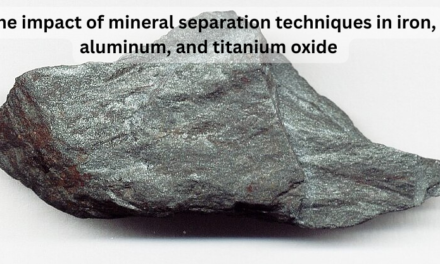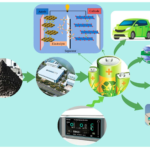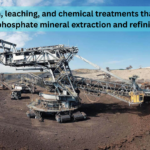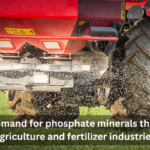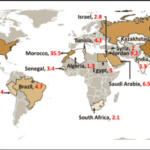Phosphate minerals are critically important in both sustainable agriculture and emerging technologies, such as lithium-iron-phosphate (LFP) batteries. Their role spans multiple sectors, supporting the growing demand for fertilizers in agriculture and contributing to the development of more sustainable and efficient technologies in energy storage. Below, I will explain how phosphate minerals play a role in these two key areas.
1. Phosphate Minerals in Sustainable Agriculture
Role in Fertilizer Production:
- Phosphate minerals, particularly apatite, are the primary source of phosphorus, one of the three main macronutrients (along with nitrogen and potassium) essential for plant growth. Phosphorus supports critical biological functions, such as energy transfer, photosynthesis, and the formation of roots, flowers, and seeds.
- The global agriculture industry relies heavily on phosphate fertilizers to replenish phosphorus in the soil, which is often depleted due to continuous cropping. Without these fertilizers, crop yields would be dramatically reduced, leading to food security challenges.
Sustainability Considerations:
- Nutrient Management: The proper use of phosphate-based fertilizers is crucial for sustainable agriculture. Over-application can lead to eutrophication, as excessive phosphate runoff contaminates water bodies, causing harmful algal blooms. Sustainable practices such as precision farming, integrated nutrient management, and the use of slow-release fertilizers can help optimize the use of phosphate and reduce environmental impacts.
- Recycling and Efficiency: Sustainable agricultural practices also involve improving the efficiency of phosphate use through better soil management, crop rotations, and utilizing phosphorus recycling technologies (e.g., recovering phosphorus from wastewater, animal manure, and food waste). This reduces dependence on mined phosphate and can help mitigate the depletion of phosphate reserves.
Role in Food Security:
- Phosphorus is essential for increasing agricultural productivity, especially in regions with limited access to arable land or fertilizer supplies. By ensuring that fertilizers derived from phosphate minerals are used sustainably, farmers can improve crop yields and ensure food security in both developed and developing countries.
2. Phosphate Minerals in Emerging Technologies: Lithium-Iron-Phosphate (LFP) Batteries
Phosphate minerals also play a critical role in emerging energy technologies, particularly in the development of lithium-iron-phosphate (LFP) batteries, which are becoming increasingly popular for electric vehicles (EVs) and energy storage systems due to their performance and safety advantages.
How Phosphate is Used in LFP Batteries:
- Lithium-Iron-Phosphate (LFP) batteries are a type of lithium-ion battery that uses iron phosphate (FePO₄) as the cathode material instead of traditional cobalt-based compounds. Phosphate plays a key role in the battery’s stability, safety, and performance.
- Iron phosphate (FePO₄) is made from phosphate minerals (particularly phosphates of iron) and has several advantages:
- Thermal stability: LFP batteries have better thermal stability, reducing the risk of overheating and fires compared to other types of lithium-ion batteries, making them safer for applications like electric vehicles and grid storage.
- Long lifespan: LFP batteries typically last longer due to their chemical stability, leading to lower maintenance costs and reduced waste over time.
- Lower cost: Iron is less expensive than other materials used in battery production, such as cobalt, making LFP batteries a more affordable option for large-scale energy storage and transportation applications.
Benefits to the Energy Transition:
- The development of LFP batteries supports the global shift toward clean energy and electric mobility. By enabling longer-lasting, cost-effective, and safe batteries, LFP batteries contribute to the widespread adoption of electric vehicles (EVs) and help store energy from renewable sources (such as solar and wind), facilitating the transition to a greener energy infrastructure.
Emerging Technologies and Sustainability:
- The shift toward using phosphate-based materials (iron phosphate) in batteries reduces the environmental impact of sourcing more problematic materials like cobalt, which has significant social and environmental challenges associated with its mining.
- The increased demand for LFP batteries is expected to lead to innovations in battery recycling and material recovery technologies. As the demand for lithium-ion batteries grows, technologies for extracting valuable materials, including phosphates, from used batteries will be essential to reducing the environmental footprint of both battery production and disposal.
Conclusion
Sustainable Agriculture: Phosphate-based fertilizers are essential for maintaining soil fertility and food production. However, to ensure long-term sustainability, it is crucial to manage phosphate resources efficiently, reduce overuse, and explore alternatives like phosphorus recycling and more efficient fertilizer formulations.Emerging Technologies: In lithium-iron-phosphate (LFP) batteries, phosphate minerals are integral to improving battery safety, lifespan, and affordability. This helps drive the transition to electric vehicles and renewable energy storage, making LFP batteries a key component of sustainable energy systems.
Hashtags
#PhosphateMinerals #SustainableAgriculture #PhosphateFertilizers #GreenFarming #LFPBatteries #SustainableTech #BatteryMaterials #CleanEnergy #AgTech #EcoFarming #PhosphateInTech #PhosphateForSustainability #LithiumIronPhosphate #RenewableEnergyTech #PhosphateInnovation #SustainableMining #CircularEconomy #TechForSustainability #AgriculturalInnovation #FutureEnergyMaterials #EcoInnovation




